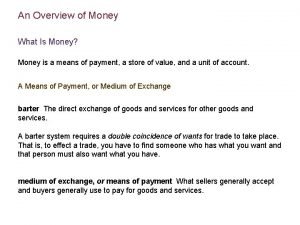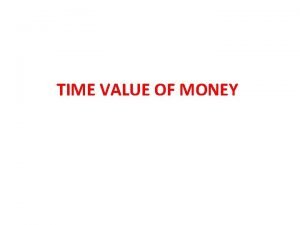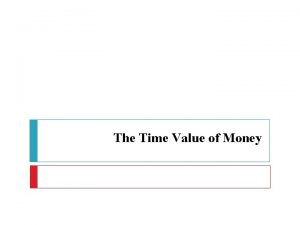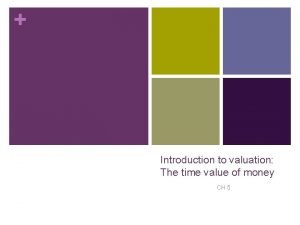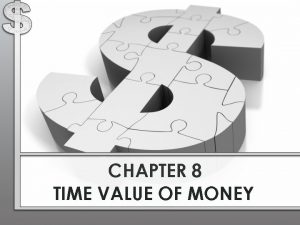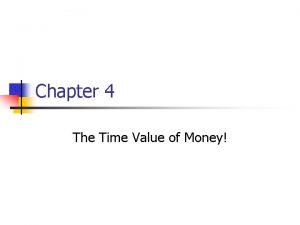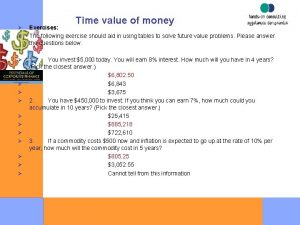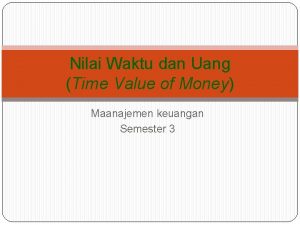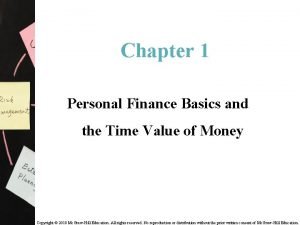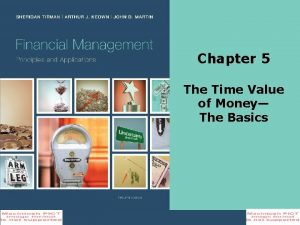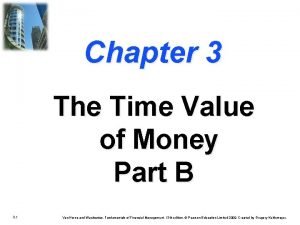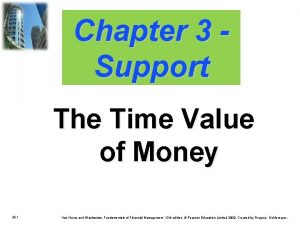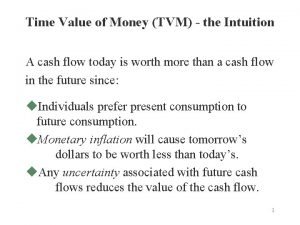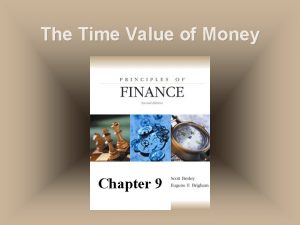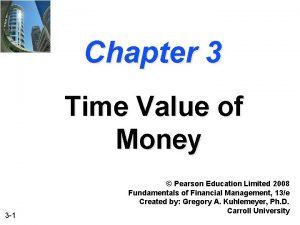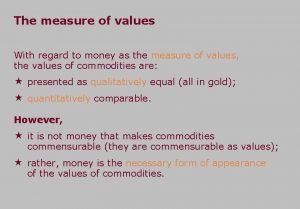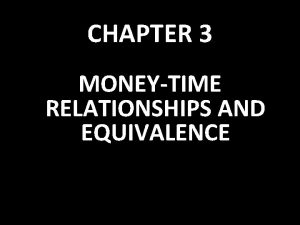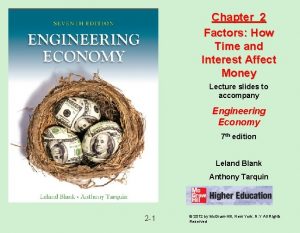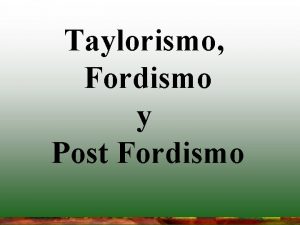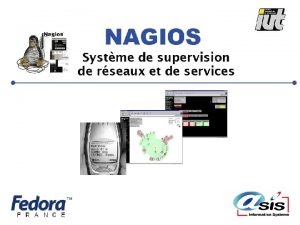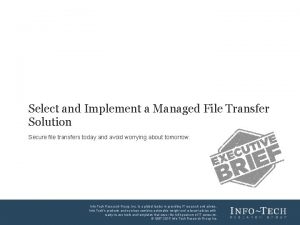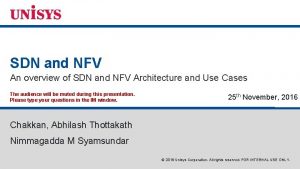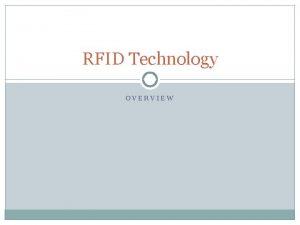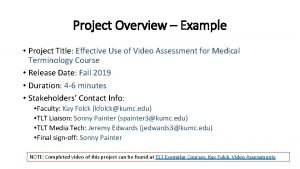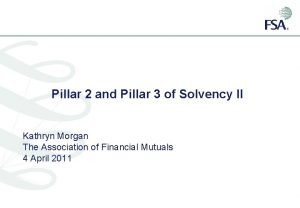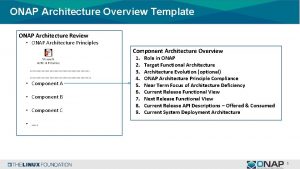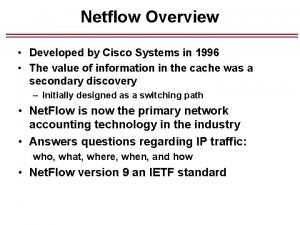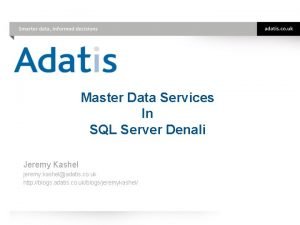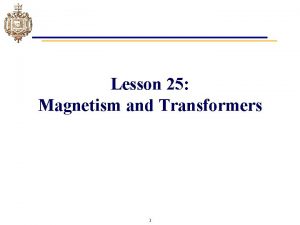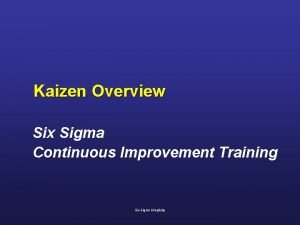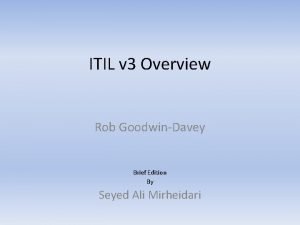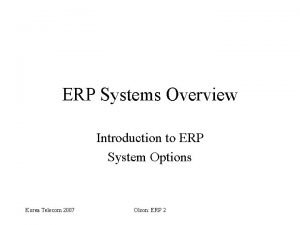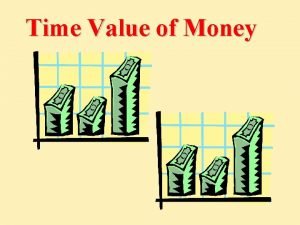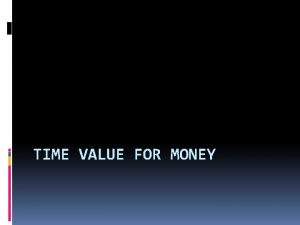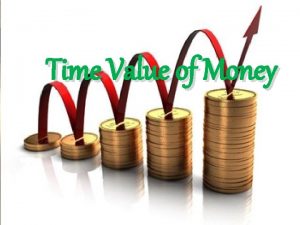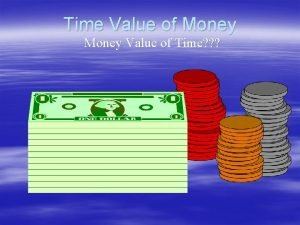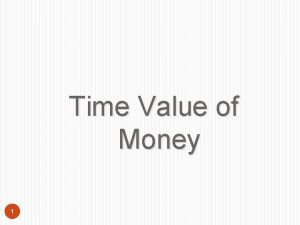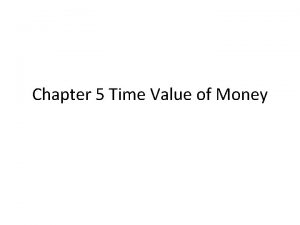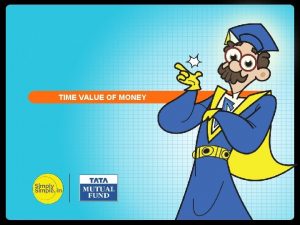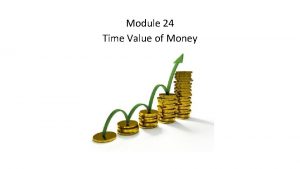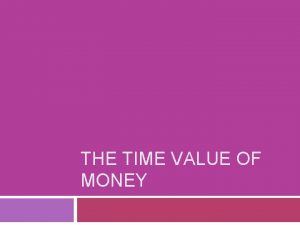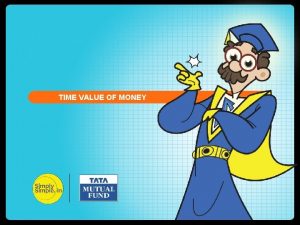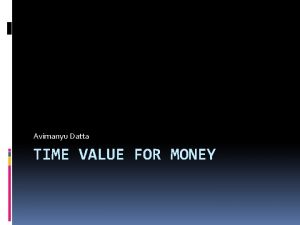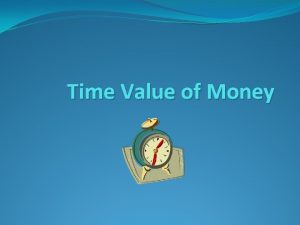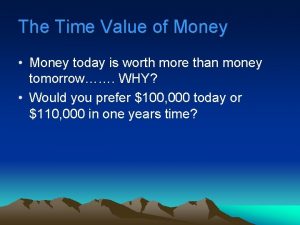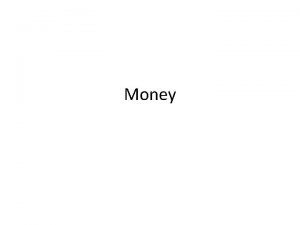TIME VALUE OF MONEY An Overview TIME VALUE






























































































- Slides: 94

TIME VALUE OF MONEY An Overview

TIME VALUE CONCEPT S Present Value – The amount an investment is worth today. Future Value – The amount an investment is worth after one or more periods. Interest rate – “exchange rate” between money today and money tomorrow • • Discount rate Cost of capital Opportunity cost of capital Required return

• • • TIMELINE S Show the timing of cash flows. Tick marks occur at the end of each period. Each tick mark corresponds to the end of one time period and the beginning of the next one.

SIMPLE VS. COMPOUND INTEREST

SIMPLE INTEREST FV with simple interest The $1, 000 investment accrues $50 each year for each of two years, So in 2 years you have: 1000 + 50 = 1, 100

SIMPLE INTEREST FV with simple interest The $1, 000 investment accrues $50 each year for each of two years, So in 2 years you have: Year 0 = (1, 000) Year 1= 1000 + 50 = 1, 050 Year 2 = 1000 + 50 = 1, 100

COMPOUND INTEREST What is the future value of $1, 000 after 2 years if the interest rate is 5% compounded annually? 1000 + 50 = 1, 050 (1. 05) =

COMPOUND INTEREST What is the future value of $1, 000 after 3 years if the interest rate is 5% compounded annually?

FV: FORMULA METHODS After 1 year: FV 1 = PV(1 + r) = $1, 000(1. 05) = $1, 050. 00 After 2 years: FV 2 = $1, 050. 00(1. 05) = $1, 102. 50 or FV 2 = PV(1 + r)2 = $1, 000(1. 05)2 = $1, 102. 50 After 3 years: FV 3 = 1, 102. 50(1. 05) = $1, 157. 63 FV 3 = PV(1 + r)3 = $1, 000(1. 05)3 = $1, 157. 63 After t years (general case): FVt = PV(1 + r)t

FUTURE VALUES: GENERAL FORMULA FV = PV(1 + r)t FV = future value PV = present value r = period interest rate, expressed as a decimal t = number of periods (time) Interest factor = (1 + r)t To find future values

FUTURE VALUES – EXAMPLE 2 Suppose you invest the $1, 000 at an interest rate of 5% for 10 years. How much would you have assuming compound interest? FV = PV(1 + r)t 1000 (1+. 05)^10 = $1, 628. 89

FUTURE VALUE – EXAMPLE 3 Suppose a relative of yours deposited $10 at 5% interest into a savings account 200 years ago. How much would the investment be worth today with simple interest? With compound interest? What is the difference? Simple 10 + 10 (0. 5) (200) = 110 Compound FV = 10 (1+1. 05) ^ 200 = 172, 925. 81

FV: USING EXCEL’S FINANCIAL TECHNOLOGY Type the formula Use a dialogue box Click on Formulas > Financial > FV. Fill in the Rate, number of periods (Nper), periodic payments (Pmt), and present value (Pv). Click OK. Type the function =FV(rate, nper, pmt, pv, type)

FV: EXCEL DIALOGUE BOX TECHNOLOGY If you invest $1000 for 5% per year how much money will you have in 3 years?

FV: EXCEL FORMULA

FUTURE VALUE – ONE MORE EXAMPLE A company currently has profits of $3 million dollars. If profits increase 4% each year, how much profit will the company earn in 10 years?

FUTURE VALUE – ONE MORE EXAMPLE A company currently has profits of $3 million dollars. If profits increase 4% each year, how much profit will the company earn in 10 years? 3 mm , i=0. 04 t = 10 FV = 3 (1. 04) ^ 10

FUTURE VALUE – ANOTHER EXAMPLE You borrow $10, 000 in student loans your freshman year at an annual interest rate of 6. 2% per year. If you have a grace year and don’t have to start paying back the loan until after you graduate, how much money do you owe 5 years later?

FUTURE VALUE – ANOTHER EXAMPLE You borrow $10, 000 in student loans your freshman year at an annual interest rate of 6. 2% per year. If you have a grace year and don’t have to start paying back the loan until after you graduate, how much money do you owe 5 years later? PV – 10, 000, i=0. 62, t= 5 10, 000 * (1. 062) ^5 = 13, 508. 98

FUTURE VALUE – ONE MORE EXAMPLE If a stock which is currently worth $32 is expected to have return 8% annually, how much will it be worth in 5 years?

FUTURE VALUE – ONE MORE EXAMPLE If a stock which is currently worth $32 is expected to have return 8% annually, how much will it be worth in 5 years? Pv = 32 I = 8. 0% 47. 02

PRESENT VALUE The amount an investment is worth today (now, at time 0). Finding the PV of a cash flow or series of cash flows is called discounting. The value of cash flows in today’s purchasing power. 0 1 2 3 10% PV = ? 100

PRESENT VALUES We can use the future value formula to find the present value. §FV = PV(1 + r)t §Rearrange to solve for PV = FV / (1 + r)t To find present values

PV: THE FORMULA METHOD How much money must you invest today if you can earn 7% and you would like to have $5, 000 in 10 years.

PV: THE FORMULA METHOD How much money must you invest today if you can earn 7% and you would like to have $5, 000 in 10 years. 75. 13

PRESENT VALUES – EXAMPLE 2 Suppose when you were born, your parents wanted to begin saving for your college education and they estimated that after 17 years you would need $150, 000. If they felt confident that they could earn 8% per year, how much did they need to invest when you were born?

PRESENT VALUES – EXAMPLE 2 Suppose when you were born, your parents wanted to begin saving for your college education and they estimated that after 17 years you would need $150, 000. If they felt confident that they could earn 8% per year, how much did they need to invest when you were born? 150, 000 , 17 years 8. 0% = 40, 540. 34

PRESENT VALUES – EXAMPLE 3 You win a raffle and have the option of two prizes. You can either receive $1000 now or $1075 at the end of the year. If the discount rate is 8%, which prize do you prefer?

PV: USING EXCEL’S FINANCIAL TECHNOLOGY Type the formula Use a dialogue box Click on Formulas > Financial > PV. Fill in the Rate, number of periods (Nper), periodic payments (Pmt), and future value (Fv). Click OK. Type the function =PV(rate, nper, pmt, fv, type)

EFFECTS OF COMPOUND INTEREST For a given interest rate – the longer the time period, the lower the present value. For a given time period – the higher the interest rate, the smaller the present value

PRESENT VALUE How much money must you invest in an account that earns 8% today if you want to have $1000 in 5 years?

PRESENT VALUE How much money must you invest in an account that earns 8% today if you want to have $1000 in 5 years? PV = FV / (1+i) ^ t PV = 1000 / (1. 08) ^ 5 = 680. 53

PRESENT VALUE How much does a car cost in today’s dollars if the dealer offers you a no money down 12% loan which requires full payment of $42, 296. 20 in 5 years?

PRESENT VALUE How much does a car cost in today’s dollars if the dealer offers you a no money down 12% loan which requires full payment of $42, 296. 20 in 5 years? PV = 42, 296. 20 / (1. 12)^5 = 24, 000

REVIEW 1 If you invest $5000 in a savings account that earns 7% per year, how much will be in the account in 10 years?

REVIEW 1 If you invest $5000 in a savings account that earns 7% per year, how much will be in the account in 10 years? FV = pv (1+i)^t $9. 835. 76

REVIEW 2 How much money must you invest today if you can earn 7% and you would like to have $5000 in 10 years?

REVIEW 2 How much money must you invest today if you can earn 7% and you would like to have $5000 in 10 years? PV = ? 2541. 75

REVIEW 3 You take a job and are offered the following payment options. If the discount rate is 8%, which option do you prefer

REVIEW 3 You take a job and are offered the following payment options. If the discount rate is 8%, which option do you prefer 1. $10000 paid in 2 years PV = 9, 245. 56 2. $12000 paid in 5 years PV = 9, 863. 13

BASIC DEFINITIONS - REVIEW Present Value – The amount an investment is worth today. Future Value – The amount an investment is worth after one or more periods. Interest rate – “exchange rate” between money today and money tomorrow Discount rate Cost of capital Opportunity cost of capital Required return

PV EQUATION PV = FV / (1 + r)t There are four parts to this equation PV, FV, r, and t If we know any three, we can solve for the fourth

INTEREST RATE Suppose you buy a stock for $30 and sell it for $33 at the end of the year and also received $1 div. How much did you earn? Amount? Rate? 33 – 30 = 3 3/30 = 10% HPR% (holding Period Return) = CF / I = (33 -30 ) /30 = 3 / 30 =. 10 = 10. )% (33 -30+1)/ 30 = 4/30 = 13. 3%

DISCOUNT RATE – EXAMPLE 1 You are looking at an investment that will pay $1, 200 in 5 years if you invest $1, 000 today. How much interest does this investment earn? FV = PV (1+i)^t 33 = 30 (1+i)^1 33/30 = 30 (1+1+i) / 30 33/30 – 1= 10. 0%

DISCOUNT RATE FORMULA Start with basic equation and solve for r FV = PV(1 + r)t

DISCOUNT RATE

DISCOUNT RATE – EXAMPLE 2 Suppose you have a 1 -year old son and you want to provide $75, 000 in 17 years toward his college education. You currently have $5, 000 to invest. What interest rate must you earn to have the $75, 000 when you need it?

DISCOUNT RATE – EXAMPLE 2 Suppose you have a 1 -year old son and you want to provide $75, 000 in 17 years toward his college education. You currently have $5, 000 to invest. What interest rate must you earn to have the $75, 000 when you need it? R = (fv / pv ) ^ 1/t – 1 = 17. 27%

DISCOUNT RATE: USING EXCEL Type the formula Use a dialogue box Click on Formulas > Financial > RATE. Fill in the, number of periods (Nper), periodic payments (Pmt), present value (pv), and future value (Fv). Click OK. Type the function = RATE(nper, pmt, pv, fv, type, guess)

INTEREST RATE Suppose you buy a home for $300, 000 and sell it 5 years later for $400, 000. What yearly interest rate did you earn? PV = 300 k, FV = 400 k t = 5 I = (400/300) ^ 1/5 – 1 = 5. 92%

INTEREST RATE Suppose you buy a home for $300, 000 and sell it 5 years later for $400, 000. What yearly interest rate did you earn?

INTEREST RATE If you buy a stock for $32 and sell it for $33. 60 one year later, what yearly interest rate did you earn? 33. 60/32 - 1 =

INTEREST RATE If you buy a stock for $32 and sell it for $33. 60 one year later, what yearly interest rate did you earn? I = 33. 60 /32) ^1/1 – 1 = 5. 0%

NUMBER OF PERIODS – EXAMPLE 1 You want to purchase a new car and you are willing to pay $20, 000. If you can invest at 10% per year and you currently have $15, 000, how long will it be before you have enough money to pay cash for the car?

NUMBER OF PERIODS – EXAMPLE 1 You want to purchase a new car and you are willing to pay $20, 000. If you can invest at 10% per year and you currently have $15, 000, how long will it be before you have enough money to pay cash for the car? FV = $20, 000, r = 10%, PV=15, 000 t=? FV = PV (1+i) ^t 20/15 = 1. 1^t Ln(20/15) = ln (1. i)^t) ln (20/15)/ ln (1. 1) = ln 1. 1 / ln (1. 1) = 3. 02 years t =

NUMBER OF TIME PERIODS Start with basic equation and solve for t (remember your logs) § FV = PV(1 + r)t

NUMBER OF PERIODS You buy a stock for $25 which you expect to grow at a rate of 7% each year. How long will it be before the stock is worth $50?

NUMBER OF PERIODS You buy a stock for $25 which you expect to grow at a rate of 7% each year. How long will it be before the stock is worth $50? PV = 25 FV = 50 I = 7. 0% T=? T = Ln (FV/PV) / ln (1+i) = ln (50/25) / ln (1. 07) = 10. 24 years

NUMBER OF PERIODS – EXAMPLE 2 If you can earn 10% annual interest, how long does it take for your investment to double? Pv = 1 FV = 2 7. 27 years rule of 72

NUMBER OF PERIODS: USING EXCEL Type the formula Use a dialogue box Click on Formulas > Financial > NPER. Fill in the Rate, periodic payments (Pmt), present value (pv), and future value (Fv). Click OK. Type the function =NPER(rate, pmt, pv, fv, type)

ANNUITIES Annuity – a finite series of equal payments that occur at regular intervals Examples

DRAWING TIMELINES $100 lump sum due in 2 years 0 I% 1 2 100 3 year $100 ordinary annuity 0 I% 1 2 3 100 100

FV OF AN ORDINARY ANNUITY EXAMPLE How much will an ordinary annuity be worth in 3 years, if it pays $100 per year and earns 10% annual interest? 100 , 100 FV = ? 100 (1. 1)^2 + 100 (1. 1) + 100 = 331

FV OF AN ORDINARY ANNUITY EXAMPLE How much will an ordinary annuity be worth in 3 years, if it pays $100 per year and earns 10% annual interest?

FV OF AN ORDINARY ANNUITY: FORMULA

FV OF AN ORDINARY ANNUITY - EXAMPLE How much will an ordinary annuity be worth in 3 years, if it pays $100 per year and earns 10% interest? (Use the formula)

FV OF AN ORDINARY ANNUITY - EXAMPLE How much will an ordinary annuity be worth in 3 years, if it pays $100 per year and earns 10% interest? (Use the formula) CF = 100, t = 3 years , FV = I = 10%, PV = 0 FV = CF ((1+i)^t ) -1 ) / r FV = 100 ((1+i)^2 – 1) / 0. 10 FV = 331

FV OF AN ORDINARY ANNUITY EXAMPLE

ANNUITY (REAL-WORLD) EXAMPLE You decide that starting when you are 20 years old you will save $3 a day for retirement. Every day you put $3 in a drawer. At the end of the year, you invest the accumulated savings ($1, 095) in a brokerage account with an expected annual return of 12%. If you continue the practice every year until you are 65, how much money will you have?

ANNUITY (REAL-WORLD) EXAMPLE You decide that starting when you are 20 years old you will save $3 a day for retirement. Every day you put $3 in a drawer. At the end of the year, you invest the accumulated savings ($1, 095) in a brokerage account with an expected annual return of 12%. If you continue the practice every year until you are 65, how much money will you have? CF = 10, 095 , FV = ? , T= 45 years, PV = 0 FV = CF ((1+r)^t – 1) / r FV = 1095 ((1+. 12)^45 – 1 /. 12 $1, 487, 261. 89

MORE EXAMPLES If you invest $100 at 5% interest how much money will you have in 8 years? FV = PV (1+r)^t = 100 (1. 05)^8 = $147. 75 If you invest $100 per year at 5% interest, how much money will you have in 8 years? FV = CF [ ((1+i)^t) – 1 ]/ r = 100 ((1. 05)^8 – 1) / 0. 05 = $954. 91

ANNUITY - CASH FLOW If you would like to have $120, 000 in your child’s college account in in 18 years and you can earn 6. 5% per year, how much must you invest each year?

WHO WANTS TO BE A MILLIONAIRE? How much money do you need to save each year to be a millionaire by the time you are 65 if you can earn an interest rate of 8% and you start saving when you are 20 years old = 2, 587. 28 30 years old = $5, 803. 26 40 years old = $13, 678. 78 When you were born = $541. 35

WHO WANTS TO BE A MILLIONAIRE? How much money do you need to save each year to be a millionaire by the time you are 65 if you can earn an interest rate of 8% and you start saving when you are 45? $21, 852. 21 30? $5, 803. 26 20? $2, 587. 28 Born? $451. 35 FV=$1 mm PV = 0 t =65 -45 = 20 years R = 8. 0% =pmt(

ANNUITY - TIME You want to buy a $40, 000 antique car. If you contribute $1200 per year to a savings account which earn 11% interest how long will it take before you can buy the car?

NUMBER OF PERIODS: USING EXCEL Type the formula Use a dialogue box Click on Formulas > Financial > NPER. Fill in the Rate, periodic payments (Pmt), present value (pv), and future value (Fv). Click OK. Type the function =NPER(rate, pmt, pv, fv, type)

ANNUITY - TIME You want to buy a $40, 000 antique car. If you contribute $1200 per year to a savings account which earn 11% interest how long will it take before you can buy the car?

ANNUITY - TIME You want to buy a $40, 000 antique car. If you contribute $1200 per year to a savings account which earn 11% interest how long will it take before you can buy the car? t= ? 14. 75 years

ANNUITY – INTEREST RATE What interest rate must you earn in order to have $500, 000 in a savings account in 20 years in you contribute $2400 per year?

ANNUITY – INTEREST RATE What interest rate must you earn in order to have $500, 000 in a savings account in 20 years in you contribute $2400 per year? R = ? , PV = o, FV = $500, 000 , t=20 , CF = $2, 400 FV = CF (I 1+r)^t – 1) / r USE EXCEL 20. 90%

DISCOUNT RATE: USING EXCEL Type the formula Use a dialogue box Click on Formulas > Financial > RATE. Fill in the, number of periods (Nper), periodic payments (Pmt), present value (pv), and future value (Fv). Click OK. Type the function = RATE(nper, pmt, pv, fv, type, guess)

ANNUITY – INTEREST RATE HPR vs Interest Rate same as IRR What interest rate must you earn in order to have $500, 000 in a savings account in 20 years in you contribute $2400 per year? =Rate (nper, pmt, pv, fv, type, guess) 20. 90%

PRESENT VALUE OF AN ANNUITY How much is an ordinary annuity currently worth, if it pays $100 per year for 3 years and earns 10% interest? $248. 68 = 100 /(1. 1)^1 + 100 / (1. 1)^2 + 100 / (1. 1)^3 = Cf / (1+r)^1, CF /(1+r)^2

PV OF AN ANNUITY: FORMULA

PV OF AN ORDINARY ANNUITY EXAMPLE How much is an ordinary annuity currently worth, if it pays $100 per year for 3 years and earns 10% interest? (Use the formula) PV = CF (1 – ( (1 / (1+r) ^ t)) / r PV = 100 (1 – (1/(1+. 1)^3 ) / 0. 10 PV = $248. 68

PRESENT VALUE OF AN ANNUITY How large a mortgage can you get if you can afford payments of $8000 per year for the next 30 years and the interest rate is 4. 68%? PMT = CF = $8, 000 , t = 30, r=4. 68%, PV = ? PV = CF (1 – 1 / (1+r)^t ) / r PV = 8, 000 (1 - 1 /(1+0. 0468)^30) / 0. 0468 PV = $127, 595. 80

PV: USING EXCEL TECHNOLOGY Type the formula Use a dialogue box Click on Formulas > Financial > PV. Fill in the Rate, number of periods (Nper), periodic payments (Pmt), and future value (Fv). Click OK. Type the function =PV(rate, nper, pmt, fv, type)

RETIREMENT After you retire, you want to withdraw $50, 000 a year from your savings account which earns 4% annual interest for 30 years. How much money do you need in your saving account when you retire?

ANNUITY – TIME If you borrow $60, 000 in student loans at an interest rate of 7. 5% and you can afford to pay $4, 800 per year how long will it take you to pay off your loans?

ANNUITY – INTEREST RATE At retirement you have $750, 000 in your savings account. You intend to withdraw $65, 000 per year. What interest rate must you earn to make your money last for the next 30 years? PV = $750, 000, PMT = $65, 000, t = 30, FV = 0, r = ? Rate = ? = 7. 74%

ANNUITY - RECAP An annuity is a financial security which consists of a finite series of equal payments that occur at regular intervals. You can find the future value of an annuity by: Adding the future values of each payment. Using the formula. Using Excel.

INTERNAL RATE OF RETURN HPR = CF / INVESTMENT BOUGHT THE STOCK AT 100 SOLD IT 120 = WHAT’S YOUR RETURN (120 -100)/100 = 20% BOUGHT 100, RECEIVED A DIV $4 SOLD AT 120 = HPR? (120 -100+4) / 100 = (20 + 4 )/100 = 24/100 =. 24 = 24%

HISTORICAL RETURN ANALYSIS

SCENARIO ANALYSIS
 Dana damian
Dana damian An overview of money
An overview of money Present value adalah
Present value adalah Objectives of time value of money
Objectives of time value of money Introduction to valuation the time value of money
Introduction to valuation the time value of money Chapter 8 time value of money answer key
Chapter 8 time value of money answer key Time value of money quiz
Time value of money quiz Time value of money exercise
Time value of money exercise Faktor yang mempengaruhi time value of money
Faktor yang mempengaruhi time value of money Diskusi tentang time value of money
Diskusi tentang time value of money Personal finance basics and the time value of money
Personal finance basics and the time value of money Time value of money
Time value of money Firmilate
Firmilate Chapter 3 time value of money problem solutions
Chapter 3 time value of money problem solutions Time value of money
Time value of money Chapter 2 time value of money solutions
Chapter 2 time value of money solutions Pengertian time value of money
Pengertian time value of money Chapter 3 time value of money problem solutions
Chapter 3 time value of money problem solutions Gatsby
Gatsby Money smart money match
Money smart money match Money on money multiple
Money on money multiple Great gatsby historical context
Great gatsby historical context Old money vs new money
Old money vs new money Penciptaan nilai adalah
Penciptaan nilai adalah Market overview real-time interaction management
Market overview real-time interaction management How to write centavos
How to write centavos Value of money meaning
Value of money meaning How to calculate future value of money
How to calculate future value of money Present and future value of money
Present and future value of money External value of money
External value of money Assessing value for money
Assessing value for money Money as a measure of value
Money as a measure of value Nilai waktu dari uang
Nilai waktu dari uang Money-time relationship and equivalence
Money-time relationship and equivalence You can buy clock but not time
You can buy clock but not time You can buy a clock but not time
You can buy a clock but not time Money-time relationship and equivalence
Money-time relationship and equivalence Geometric gradient formula
Geometric gradient formula You can buy a clock but not time
You can buy a clock but not time Time is money fordismo
Time is money fordismo Save your time and money
Save your time and money For minutes. start.
For minutes. start. Www overview
Www overview Maximo work order priority
Maximo work order priority Universal modeling language
Universal modeling language In uml is a connection among things
In uml is a connection among things Vertical retailers
Vertical retailers Figure 12-1 provides an overview of the lymphatic vessels
Figure 12-1 provides an overview of the lymphatic vessels Pulmonary circulation system
Pulmonary circulation system Texas recapture districts
Texas recapture districts Walmart introduction
Walmart introduction Stylistic overview of philippine art
Stylistic overview of philippine art What is sa/sd methodology?
What is sa/sd methodology? Spring framework overview
Spring framework overview Nagios tactical overview
Nagios tactical overview Market overview managed file transfer solutions
Market overview managed file transfer solutions Sdn vs nfv
Sdn vs nfv Sbic program
Sbic program Sap mm overview
Sap mm overview Ariba registration process
Ariba registration process Safe overview
Safe overview Rfid technology overview
Rfid technology overview Overview in research example
Overview in research example Perbedaan replikasi virus dna dan rna
Perbedaan replikasi virus dna dan rna Example of a project overview
Example of a project overview Blood supply of stomach flowchart
Blood supply of stomach flowchart Abstract vs summary
Abstract vs summary Solvency 2 pillar 3
Solvency 2 pillar 3 What is physical storage media
What is physical storage media Overview of education in health care
Overview of education in health care Marcus scheuren
Marcus scheuren Ospf overview
Ospf overview Architecture review template
Architecture review template What happens in scene 3 of oedipus rex
What happens in scene 3 of oedipus rex Cisco top talkers
Cisco top talkers Overview on the national tuberculosis elimination program
Overview on the national tuberculosis elimination program Mpls header format
Mpls header format Azure blob storage price
Azure blob storage price Master data services overview
Master data services overview Overview of cellular respiration
Overview of cellular respiration Overview of cellular respiration
Overview of cellular respiration Cellular respiration
Cellular respiration Overview of cellular respiration
Overview of cellular respiration Transformer overview
Transformer overview Kaizen overview
Kaizen overview Itil brief overview
Itil brief overview Iptv technology overview
Iptv technology overview Overview of mobile computing
Overview of mobile computing Overview of microprocessor
Overview of microprocessor Background kfc
Background kfc Moritz zimmermann sap
Moritz zimmermann sap Huawei company overview
Huawei company overview Eylf meaning
Eylf meaning Erp 2 systems
Erp 2 systems Sql server master data management
Sql server master data management

